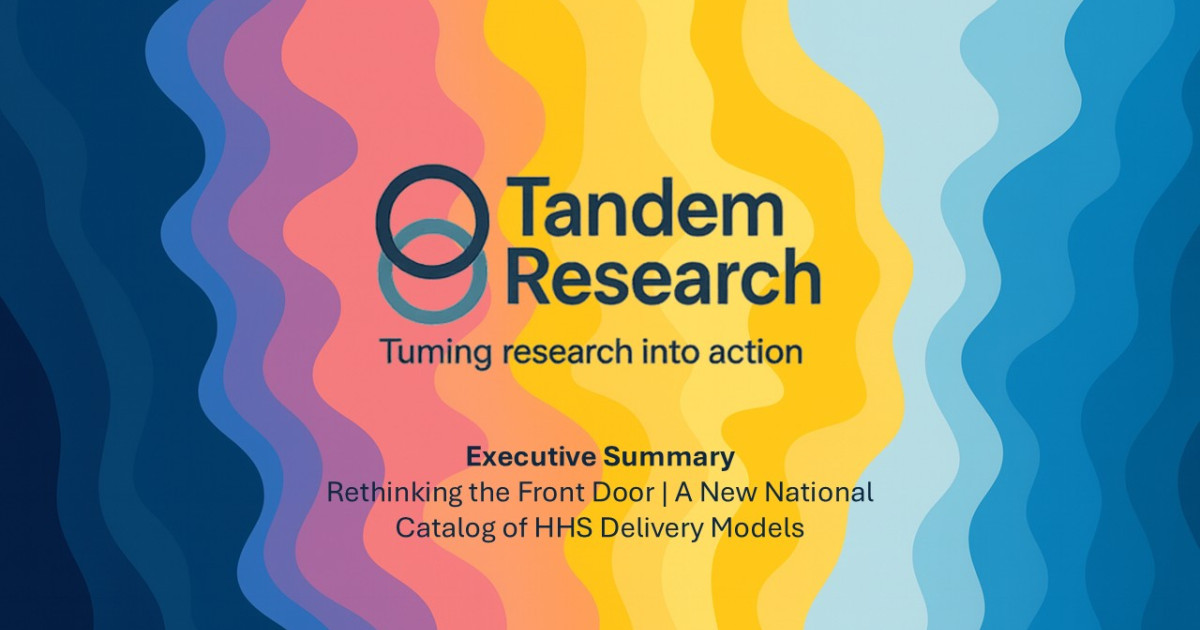Rethinking the Front Door: A New National Catalog of HHS Delivery Models

Rethinking the Front Door: A New National Catalog of HHS Delivery Models
Across the country, state and local agencies are reimagining how to serve people with dignity, efficiency, and care. From redesigned lobbies and mobile service units to AI-supported case management, a quiet revolution in Health and Human Services (HHS) delivery is already underway.
Tandem Research, a Global True North company, is releasing the National HHS Delivery Model Catalog – Executive Summary, a first-of-its-kind analysis designed to help leaders see the bigger picture of what modernization really looks like in practice.
About the Study
This national research effort analyzed more than 40 contemporary delivery model innovations across 25 states. Each model was reviewed through an independent methodology that looked at design intent, operating conditions, maturity, and outcomes.
Rather than focus on one-off programs or pilot projects, the study identifies patterns in how agencies are transforming their operations. These patterns reveal where innovation is truly taking hold and how forward-thinking leaders are reshaping the delivery experience to be more human-centered, data-informed, and resilient.
What the Research Found
Tandem Research identified eight major categories of delivery model innovation that are defining the future of HHS systems:
Community Partnerships and Embedded Workers – Embedding staff within trusted local settings like schools, clinics, and nonprofits to reach families earlier and strengthen trust.
Real Estate Modernization – Redesigning offices and administrative spaces to promote safety, dignity, and throughput.
Mobile Service Delivery – Bringing enrollment, document collection, and outreach directly into communities through mobile units and pop-up teams.
Tech-Driven Case Management – Leveraging AI, automation, and analytics to prepare cases, validate data, and reduce backlogs while keeping humans in the loop.
Co-Location (Public/Public Partnerships) – Creating a single, coordinated front door by housing multiple government functions in one place.
Intensive Case Management – Centering high-touch, goal-oriented pathways around employment, housing, or health stabilization.
Integrated Online Portals – Simplifying access through unified, mobile-friendly digital entry points.
Modernized Contact Centers – Using cloud technology and conversational automation to deliver consistent, bilingual, and equitable service statewide.
Across these categories, leading agencies are blending digital and physical access points, aligning data across systems, and investing in human-centered design to improve both client experience and workforce sustainability.
Why It Matters
The research makes one point clear: success in HHS modernization is not about isolated tools or technology upgrades. It is about coordinating systems, relationships, and design choices around shared outcomes—stability, safety, health, and equitable access.
Leaders who embrace this systems-level view are building the next generation of public service delivery: one that is responsive, efficient, and deeply human.
Explore the Full Study
The Executive Summary offers a high-level overview of the eight categories and the cross-cutting patterns observed across states. The full catalog, available to clients, includes detailed case briefs, maturity markers, implementation checklists, and insights into enabling conditions for success.
If you are a state or county HHS leader working to modernize delivery systems or strengthen agency performance, this study provides a national benchmark for your efforts.
Download the Executive Summary to explore how your agency compares to national trends.
Contact Tandem Research to access the full catalog or discuss how these models can be applied in your state.
Authored independently by Tandem Research, a Global True North company. Findings and conclusions are the authors’ own and not necessarily those of clients or partners.


